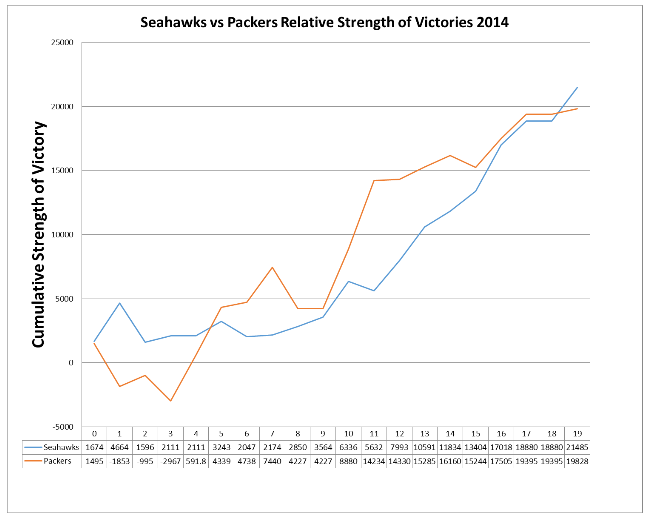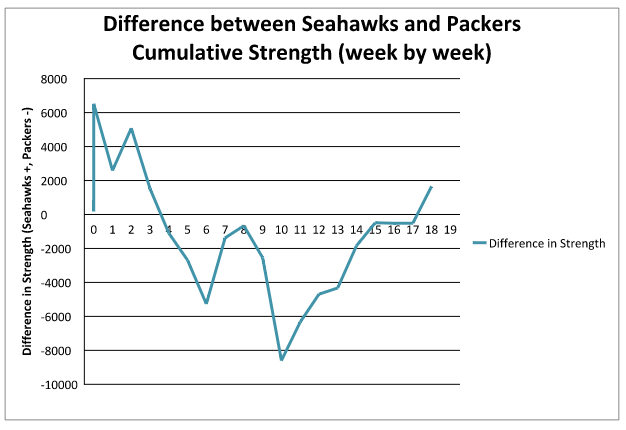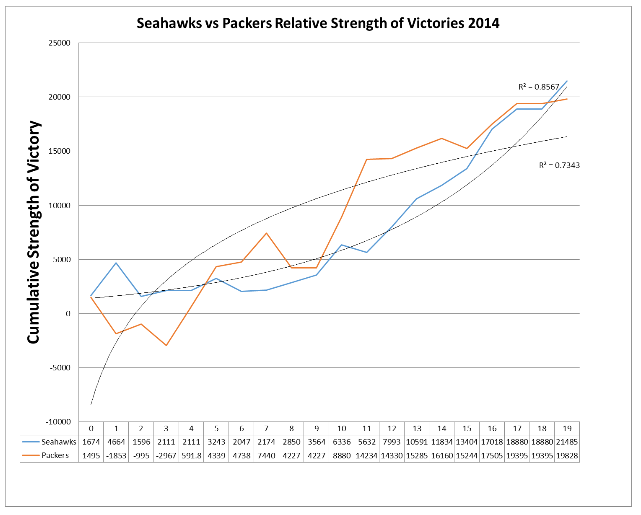https://www.youtube.com/watch?v=MAyzqMhd2i4
It’s the NFC Championship fellow Urbanists! I’m sure you’ve all noticed that the Town has been electric since Thanksgiving when the Hawks started their current 7 game win playoff run. The Green Bay Packers are guests in our house at 12:05 PM today and it’s going to be a blast! The road to the Super Bowl in Glendale, AZ will continue for us after today’s game and here’s why:
Relative strength of victory against the relative strength of opponent (RSVRSO).
Now what is that? Relative strength of victory against the relative strength of opponent is a stat that primarily counts the offensive points scored per drive (OPPD) plus the defensive points scored per opponent’s drive (DPPOD) minus the defensive points allowed per opponent’s drive (DPPOD) and the opponent’s defensive points scored per drive (ODPPD). This is what those words looks like:
(OPPD+DPPOD) – (DPPOD+ODPPD)
If the above value is positive then it means a team’s offense scored more points per drive than its defense gave up to the opposing team. That means the team won.
If the above value is negative then it means a team’s offense scored less points per drive than its defense gave up to the opposing team. That means the team lost.
Finally, the RSVRSO is computed by multiplying the above positive or negative scalar to the opponent’s Elo rating. I’ve been getting the Elo rating on a week by week basis from Nate Silver’s 538 Blog. An explanation of Elo can be found here.
After mashing up all those numbers on a week by week basis, I was able to chart the ongoing strength of victories relative to their opponents for both the Seahawks and the Packers. This is what I found:

As you can see, in week 1 the Packers dropped due to a vicious 20 point beating from the Seahawks offense and stifling defense. They continued to drop in cumulative strength in week 3 with a loss to the Lions. The Pack didn’t really hit the gas until week 10 and 11 when they badly beat the Bears and the Eagles.
As you can see with the Hawks, the season started with a bang in week 1 and a loss in week 2. The beginning of the season was a hard one. Sure there were victories but they were close which the RSVRSO doesn’t reward greatly. But then there was Thanksgiving when our Seahawks beat the Santa Clara 49ers in Santa Clara 19-3. The Hawks haven’t looked back since.
Here is a look at the difference between the Hawks and the Packers (the value between the lines):

The Packers had the upper hand in strength between weeks 5 and 18 with the peak coming in week 11 (Hawks lost to the Chiefs 24-20 and the Pack beat the Eagles 53-20), but ever since then, the Hawks RSVRSO has been on a tear. Hawks now have the lead by 1657 points (not the 6517 points that was the result of week 1).
Now here is the most tantalizing graph:

The Hawks’ season can be best fit with an exponential curve. The Packers’ season is best fit with a logarithmic curve. Exponential curves start slow in the beginning but gain steam further along the x axis (later in the season.) Logarithmic curves peak early but plateau further along the x axis. While these teams may be close in final RSVRSO, the charts of their seasons are drastically different. One spells a trip to the Super Bowl. The other spells the fate of most visiting teams in the Clink.
Seahawks 34. Packers 20.
UPDATE: This article has been fixed since publication. Apologies for the graphical errors.

Caelen Ball
Caelen is a third generation son of Ballard. When he was in high school, his parents moved the family out to beautiful Bainbridge Island where he found himself missing urban life--homesickness for Seattle continued on into his college pursuits. Classically trained in structural engineering with an emphasis in earthquake design, he loves steel, glass, and concrete. He primarily writes about Ballard land use (hopefully home to future TOD) and Sound Transit packages, both emphasizing long-range planning.


